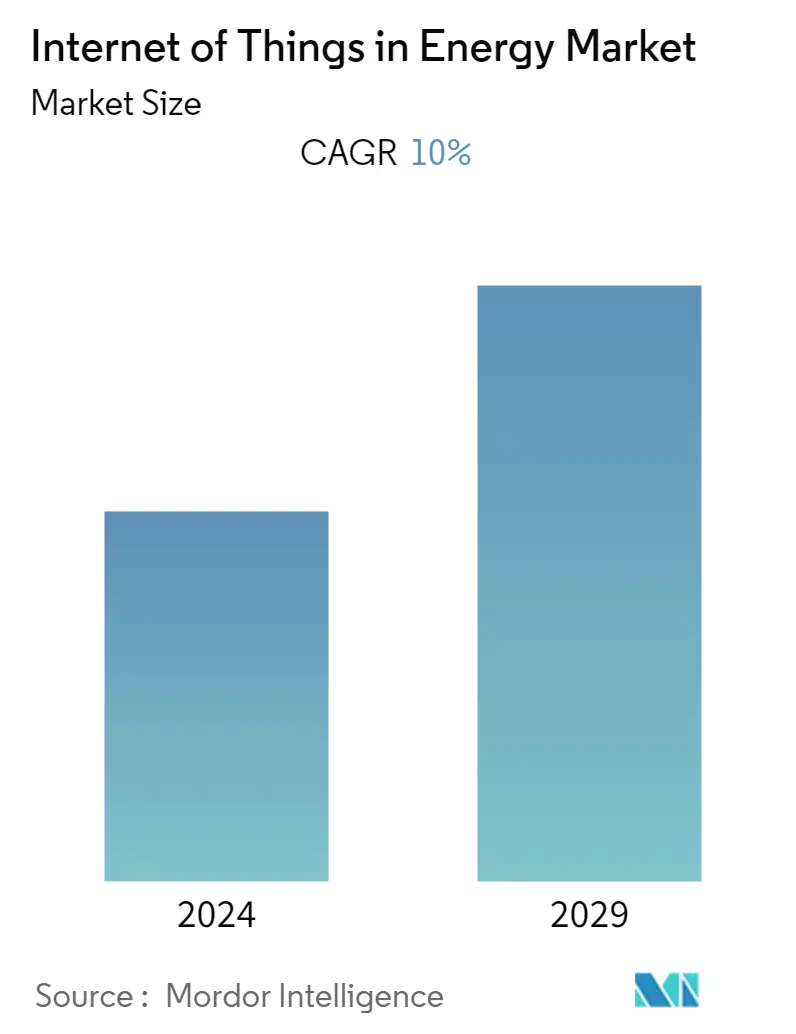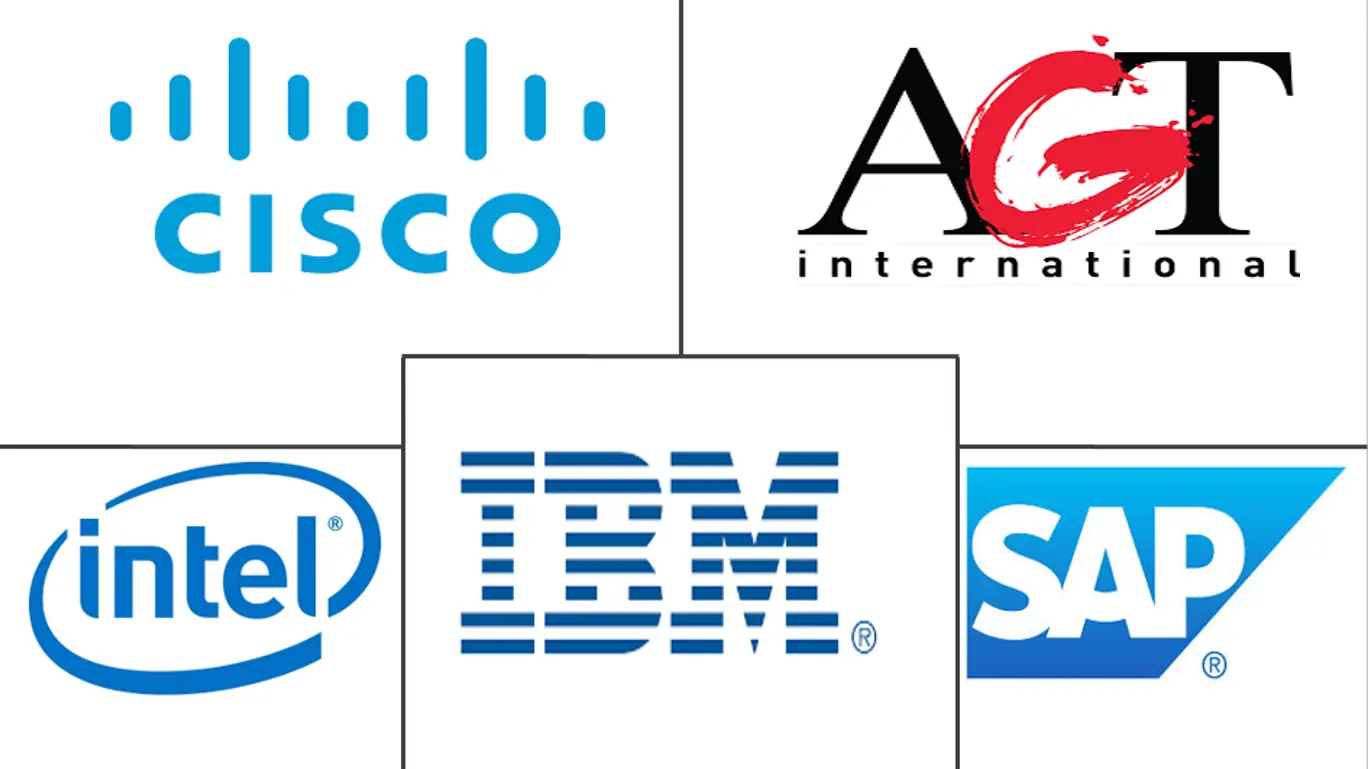Market Size of Internet of Things in Energy Industry

| Study Period | 2019 - 2029 |
| Base Year For Estimation | 2023 |
| CAGR | 10.00 % |
| Fastest Growing Market | Asia Pacific |
| Largest Market | North America |
| Market Concentration | Low |
Major Players
*Disclaimer: Major Players sorted in no particular order |
Internet of Things in the Energy Market Analysis
The Internet of Things in the energy market is expected to witness a CAGR of 10% over the forecast period. According to the International Energy Agency, as a critical enabler of modern life, the energy sector, despite being significantly affected by the COVID-19 pandemic, is also essential for global and national response and recovery efforts.
- The Internet of Things (IoT) is expected to impact the energy sector significantly. From monitoring the temperature of a room using sensors to complex applications that control the energy use of an entire building, IoT helps in cost-cutting.
- Organizations can independently monitor their equipment, including machinery, lighting, heating, and air conditioning systems. IoT device data is analyzed to develop strategies for increasing efficiency. IoT solutions also assist in remotely controlling and regulating systems to establish the highest possible energy production efficiency.
- The decreasing natural resources that produce energy and the increasing wastage of energy have drawn the attention of various nations worldwide to innovate solutions that reduce energy wastage and adopt solutions that offer high efficiency.
- A predictive analytics network monitors the data from sensors embedded in power grids. Thus, machinery can reduce energy transmission and distribution losses, making energy consumption highly efficient and cost-effective worldwide.
- Companies such as Nexus Solutions offer connected solutions to monitor and reduce energy consumption in buildings. Aquicore is also developing an analytics platform that connects to energy meters that have already been installed, enabling organizations to make decisions that improve staff productivity and reduce energy wastage.
- However, integrating new sustainable distributed energy resources (DER) into the existing grid is designed to distribute centrally generated energy, which is quite challenging.
- IoT was beneficial for the energy sector during the pandemic, from sensors that enable monitoring of room temperatures to managing energy usage from a distance, resulting in sustainable development and cost reduction. Additionally, several IoT systems made it possible to use renewable energy, reducing pollution and exploiting non-renewable resources, enabling enterprises to continue operating despite government lockdowns out of concern for employee safety. For the majority of tasks in businesses in this industry during the pandemic, IoT enabled remote working.
Internet of Things in the Energy Industry Segmentation
IoT technology in the energy sector cuts costs and creates more productive connected buildings. The Internet of Things in the energy market provides different hardware, software, services, connectivity, and integrated solutions.
The Internet of Things in the Energy Market is segmented by Type (Hardware, IoT Software, IoT Platform, IoT Security, and IoT Services) and Geography. The market sizes and forecasts are provided in terms of value (USD million) for all the above segments.
| Type | ||||||
| ||||||
| IoT Software | ||||||
| IoT Platform | ||||||
| IoT Security | ||||||
| IoT Services |
| Geography | |
| North America | |
| Europe | |
| Asia Pacific | |
| Latin America | |
| Middle East and Africa |
Internet of Things in Energy Market Size Summary
The Internet of Things (IoT) is poised to transform the energy sector significantly, driving efficiency and cost savings through advanced monitoring and control systems. By enabling organizations to independently oversee equipment such as machinery, lighting, and HVAC systems, IoT solutions facilitate the development of strategies aimed at enhancing energy efficiency. The sector's focus on reducing energy wastage and optimizing resource use is further supported by predictive analytics networks that monitor data from sensors embedded in power grids, minimizing transmission and distribution losses. Companies like Nexus Solutions and Aquicore are at the forefront, offering connected solutions and analytics platforms that empower organizations to make informed decisions, thereby improving productivity and reducing energy consumption. Despite challenges in integrating new sustainable distributed energy resources into existing grids, IoT has proven beneficial, especially during the COVID-19 pandemic, by enabling remote monitoring and control, which supported sustainable development and cost reduction.
The adoption of IoT technologies, such as smart meters, has been a significant trend in the energy market, particularly in North America, where rapid digitalization and technological advancements have fueled growth. Smart meters interconnect buildings with the smart energy grid, allowing for more effective energy flow management and enabling dynamic pricing based on real-time demand. Governments and energy companies are investing in IoT to facilitate localized green energy production and improve service delivery while reducing costs. The competitive landscape is characterized by high rivalry, with large companies acquiring startups to drive innovation. Notable acquisitions, such as Intel Corporation's acquisition of Granulate Cloud Solutions Ltd, highlight the industry's focus on real-time optimization and cost reduction. The market's fragmented nature presents lucrative opportunities, with increasing awareness of energy waste control and cost-effectiveness driving further adoption of IoT solutions.
Internet of Things in Energy Market Size - Table of Contents
-
1. MARKET DYNAMICS
-
1.1 Market Overview
-
1.2 Industry Attractiveness - Porter's Five Forces Analysis
-
1.2.1 Threat of New Entrants
-
1.2.2 Bargaining Power of Buyers/Consumers
-
1.2.3 Bargaining Power of Suppliers
-
1.2.4 Threat of Substitute Products
-
1.2.5 Intensity of Competitive Rivalry
-
-
1.3 Industry Value Chain Analysis
-
1.4 Assessment of COVID-19 Impact on the Industry
-
1.5 Market Drivers
-
1.5.1 Increasing Awareness of Energy Consumption Control
-
-
1.6 Market Restraints
-
1.6.1 High Risk Associated with Data
-
-
-
2. MARKET SEGMENTATION
-
2.1 Type
-
2.1.1 Hardware
-
2.1.1.1 Smart Thermostats
-
2.1.1.2 Smart Meters
-
2.1.1.3 EV Charging Stations
-
2.1.1.4 Other Types of Hardware
-
-
2.1.2 IoT Software
-
2.1.3 IoT Platform
-
2.1.4 IoT Security
-
2.1.5 IoT Services
-
-
2.2 Geography
-
2.2.1 North America
-
2.2.2 Europe
-
2.2.3 Asia Pacific
-
2.2.4 Latin America
-
2.2.5 Middle East and Africa
-
-
Internet of Things in Energy Market Size FAQs
What is the current Internet of Things in Energy Market size?
The Internet of Things in Energy Market is projected to register a CAGR of 10% during the forecast period (2024-2029)
Who are the key players in Internet of Things in Energy Market?
AGT International, Cisco Systems Inc., IBM Corporation, Intel Corporation and SAP SE are the major companies operating in the Internet of Things in Energy Market.

